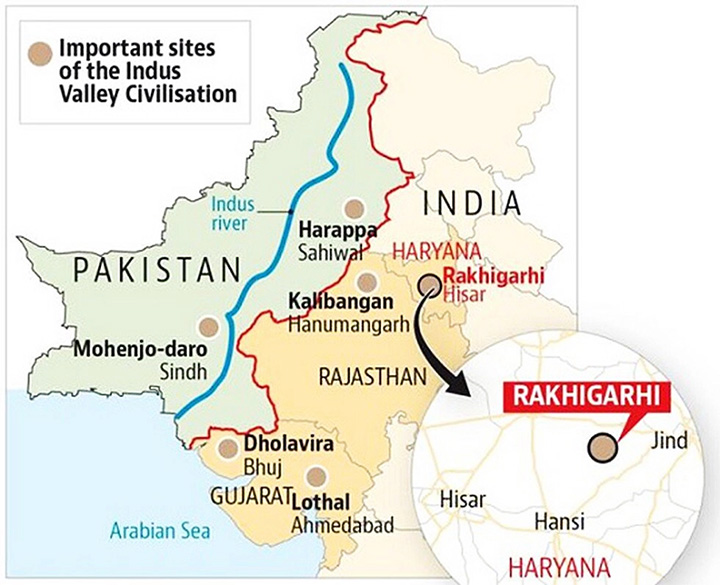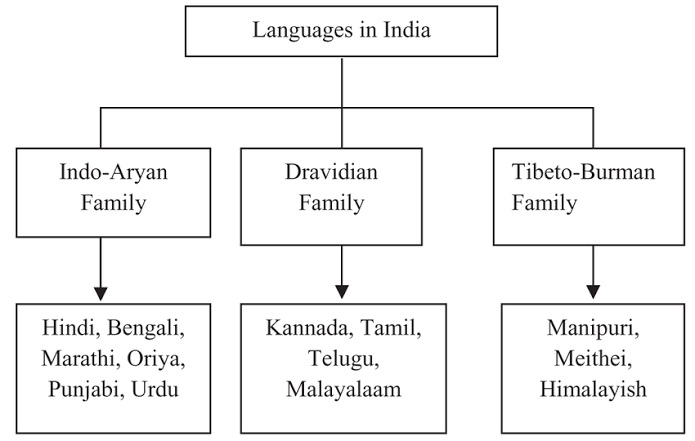Indian History
Linguistic Culture of Indus Valley
- 23 Aug 2021
- 7 min read
Why in News
A new research paper has provided some new insight on the linguistic culture of the Indus Valley Civilization (IVC).
- Earlier, a study found that the diet of the people of IVC had a dominance of meat, including extensive eating of beef.
- In July 2021, UNESCO announced the Harappan city of Dholavira in Gujarat as India’s 40th world heritage site.
Key Points
- IVC & Dravidian Language:
- IVCs have their language roots in Proto-Dravidian, which is the ancestral language of all the modern Dravidian languages.
- The basic vocabulary items of a significant population of the IVC must have been proto-Dravidian, or that ancestral Dravidian languages must have been spoken in the Indus Valley region.
- The speakers of ancestral Dravidian languages had a greater historic presence in northern India including the Indus Valley region from where they migrated.
- Proto-Dravidian was one among several languages being spoken in the Indus Valley region.
- The research claims that there were more than one or one group of languages spoken across the one-million square kilometre area of IVC.
- IVCs have their language roots in Proto-Dravidian, which is the ancestral language of all the modern Dravidian languages.
- IVC & Other Civilizations:
- Few words in Akkadian (language spoken in ancient Mesopotamia) had roots in the Indus Valley.
- The study took into account the thriving trade relations between the IVC and the Persian Gulf as well as Mesopotamia.
- Mesopotamian civilizations formed on the banks of the Tigris and Euphrates rivers in what is today Iraq and Kuwait.
- Elephant-ivory was one of the luxury goods coveted in the Near East, and archaeological, and zoological evidence confirms that Indus Valley was the sole supplier of ancient Near East’s ivory in the middle-third to early-second millennium BC.
- Near East, usually the lands around the eastern shores of the Mediterranean Sea, including northeastern Africa, southwestern Asia, and, occasionally, the Balkan Peninsula.
- Since people of ancient Persia had functioned as intermediaries between Mesopotamia and IVC traders, while exporting IVC’s ivory, they had arguably spread the Indic words to Mesopotamia as well.
- Few words in Akkadian (language spoken in ancient Mesopotamia) had roots in the Indus Valley.
Indus Valley Civilisation
- About:
- Indus civilization, also called Indus valley civilization is the earliest known urban culture of the Indian subcontinent.
- It is also called Harappan Civilization after the first city to be excavated, Harappa (Punjab, Pakistan).
- Among the world’s three earliest civilizations—the other two are those of Mesopotamia and Egypt—the Indus civilization was the most extensive.
- Indus civilization, also called Indus valley civilization is the earliest known urban culture of the Indian subcontinent.
- Time Period:
- It was established around 3300 BC. It flourished between 2600 BC and 1900 BC. It started declining around 1900 BC and disappeared around 1400 BC.
- Geographical Extent:
- Covered Punjab, Sindh, Balochistan, Rajasthan, Gujarat and Western Uttar Pradesh.
- It extended from Sutkagengor (in Balochistan) in the West to Alamgirpur (Western UP) in the East; and from Mandu (Jammu) in the North to Daimabad (Ahmednagar, Maharashtra) in the South. Some Indus Valley sites have also been found as far away as Afghanistan.
- Important Sites:

- Kalibangan (Rajasthan), Lothal, Dholavira, Rangpur, Surkotda (Gujarat), Banawali (Haryana), Ropar (Punjab).
- In Pakistan: Harappa (on river Ravi), Mohenjodaro (on Indus River in Sindh), Chanhudaro (in Sindh).
- Some Important Features:
- The Indus Valley cities show a level of sophistication and advancement not seen in other contemporary civilizations.
- Most cities had similar patterns. There were two parts: a citadel and the lower town showing the presence of hierarchy in society.
- Most cities had a Great Bath.
- There were also granaries, 2-storied houses made of burnt bricks, closed drainage lines, excellent stormwater, and wastewater management system, weights for measurements, toys, pots, etc.
- A large number of seals have been discovered.
- Agriculture:
- The first civilization to cultivate cotton.
- Animals were domesticated like sheep, goats, and pigs.
- Crops were wheat, barley, cotton, ragi, dates, and peas.
- Trade was conducted with the Sumerians (Mesopotamia).
- Metal Products :
- These were produced including those with copper, bronze, tin, and lead. Gold and silver were also known.
- Iron was not known to them.
- Religious Beliefs:
- No structures like temples or palaces have been found.
- The people worshipped male and female deities.
- A seal which was named ‘Pashupati Seal’ has been excavated and it shows an image of a three-eyed figure.
- Pottery:
- Excellent pieces of red pottery designed in black have been excavated.
- Faience was used to make beads, bangles, earrings, and vessels.
- Art Forms:
- A statuette named ‘Dancing Girl’ has been found from Mohenjodaro and is believed to be 4000 years old.
- A figure of a bearded Priest-King has also been found from Mohenjodaro.
- Other Facts:
- Lothal was a dockyard.
- Disposal of the dead was by burial in wooden coffins.
- The Indus Valley script has not yet been deciphered.
Proto-Dravidian Language
- It is the linguistic reconstruction of the common ancestor of the Dravidian languages. Proto-Dravidian gave rise to 21 Dravidian Languages.
Dravidian languages
- Dravidian languages, a family of some 70 languages spoken primarily in South Asia. They are spoken by more than 215 million people in India, Pakistan, and Sri Lanka.
- The Dravidian languages with the most speakers are (in descending order of number of speakers) Telugu, Tamil, Kannada and Malayalam, all of which have long literary traditions. Smaller literary languages are Tulu and Kodava.
- There are also a number of Dravidian-speaking Scheduled Tribes, such as the Kurukh in Eastern India and Gondi in Central India.
- Dravidian place names along the Arabian Sea coasts and Dravidian grammatical influence such as clusivity in the Indo-Aryan languages, namely, Marathi, Gujarati, Marwari, and Sindhi, suggest that Dravidian languages were once spoken more widely across the Indian subcontinent.







